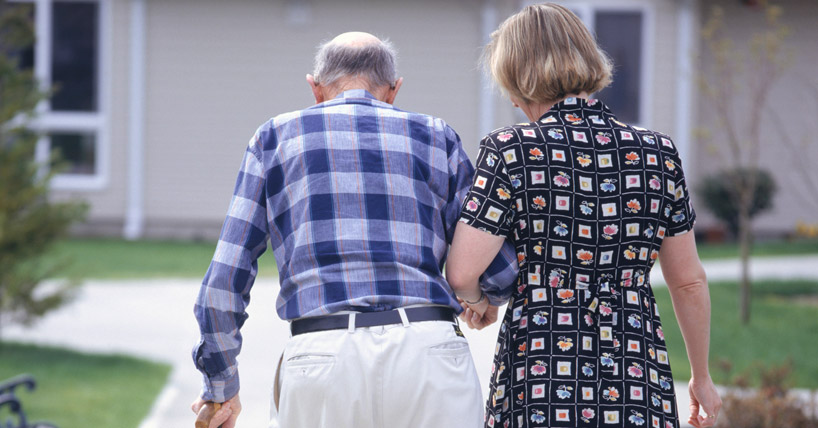Ageing study
Number of very old needing round-the-clock care set to double
Published on: 31 August 2018
The number of adults aged 85 years and older needing round-the-clock care will almost double to 446,000 in England over the next 20 years, a new study has revealed.
For the first time, experts at Newcastle University have devised a unique model to provide estimates of the numbers of older people in England who will require different levels of care.
Their study, published today in The Lancet Public Health, reveals that the total number of over-65s requiring 24-hour care will rise by more than a third to over one million in 2035.

Study’s results
Findings of the study – funded by the Economic and Social Research Council and the National Institute for Health Research - highlight the importance of ensuring health and social care services adapt to the unprecedented needs of an increasing older population with complex care needs.
However, it is estimated that the number aged 65 years and older who are independent and do not need care will rise to 8.9 million by 2035 in England – an increase of over 60% from 5.5 million in 2015, with the upturn in independence seen primarily in men.
Professor Carol Jagger, from Newcastle University’s Institute for Ageing, who led the study, warns that relying on the informal carers who provide around £57 billion worth of care in the UK is not a sustainable solution for the larger numbers requiring 24-hour care in the future.
She said: “The challenge is considerable. Older spouse carers are increasingly likely to be living with disabilities themselves, resulting in mutual care relationships that are not yet well recognised by existing care policy and practices.
“On top of that, extending the retirement age of the UK population is likely to further reduce the informal and unpaid carer pool, who have traditionally provided for older family members.
“These constraints will exacerbate pressures on already stretched social care budgets.”
Little research has focused on how levels of dependency might change for different generations of older people, and forecasts of future care needs remain poorly defined due to limitations of previous models.
Until now, models have included limited information on the key sociodemographic and lifestyle factors and chronic conditions that impact disability and dependency.
New model
To improve the precision of social care need forecasts, researchers from Newcastle University and the London School of Economics and Political Science developed a new model that accounts for multiple risk factors for dependence and disability.
The Population Ageing and Care Simulation (PACSim) model accounts for multiple risk factors for dependence and disability, including level of education and health behaviours, such as smoking, obesity and physical activity.
In addition, PACSim focuses on 12 chronic diseases and geriatric conditions, including coronary heart disease, stroke, hypertension, diabetes, arthritis, cancer, respiratory disease, cognitive impairment, and depression.
Using data from three large nationally representative studies, the researchers modelled future trends in social care needs for the population aged 65 years and older in England between 2015 and 2035, according to varying levels of dependency.
Adults were categorised as high dependency if they required 24-hour care; medium dependency if they needed help at regular times daily; low dependency if they required care less than daily and were generally looked after in the community; or independent.
Men vs women
Estimates suggest the number of people aged over 65 will increase by just under 50% from 9.7 million in 2015 to 14.5 million in 2035, and highlight the very differing future care needs of men and women.
Between 2015 and 2035 life expectancy of men aged 65 will rise by 3.5 years to 22.2 years, and the average number of years spent independent is expected to increase by 4.2 years (from 11.1 years to 15.2), whilst time spent living with substantial care needs is likely to decline.
In contrast, for women average life expectancy at 65 will increase by 3 years (from 21.1 to 24.1). Over this time, the average number of years of independence is expected to rise by less than a year (from 10.7 years to 11.6).
Women will spend almost half of their remaining life with low dependency needs, such as help with activities like washing and shopping, alongside a small increase in years requiring intensive 24-hour care.
Professor Jagger said: “Over the next 20 years, although young-old cohorts are more likely to enter old age independent, the proportion of adults with multi-morbidities is projected to rise with each successive cohort, and this will result in a greater likelihood of higher dependency with further ageing.
“However, trends for men and women are likely to be very different, with women experiencing more low level dependency than men, highlighting the importance of focusing on disabling long-term conditions, such as arthritis that are more common in women than men.”
Dementia impact
The researchers also analysed how the burden of dementia with and without other chronic diseases will change demands for social care over the next 20 years.
They found that older people with substantial care needs are likely to change markedly. For example, whilst numbers of these with dementia alone will fall by around a third by 2035, numbers with dementia and two or more other conditions will more than double.
Professor Jagger said: “This expanding group of very dependent older adults will have more complex care needs that are unlikely to be met adequately without improved co-ordination between different specialties and better understanding of the way in which dementia affects the management of other conditions.”
The authors note several limitations, including that the models assume that the effect of risk factors on disability remains constant over time, and that they did not include other risk factors that might impact dependency and disability such as alcohol use.
It is hoped that with further research, PACSim may be able to provide estimates of the numbers of older people who will require varying levels of care at different geographical locations, such as local authorities.
Reference
DOI: 10.1016/S2468-2667(18)30118-X
Andrew Kingston, Adelina Comas-Herrera, Professor Carol Jagger
The Lancet Public Health.




